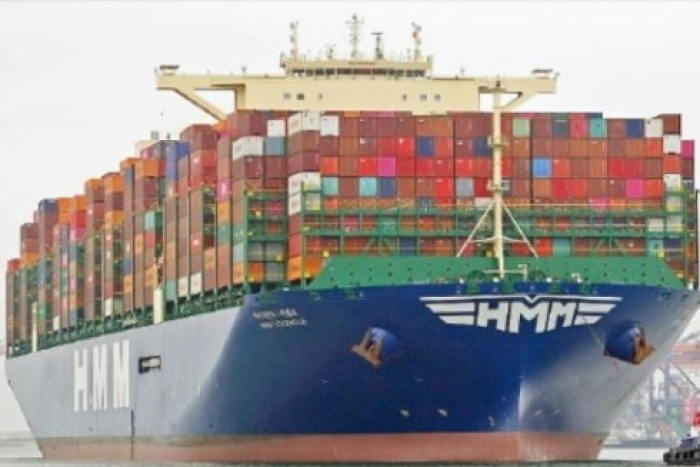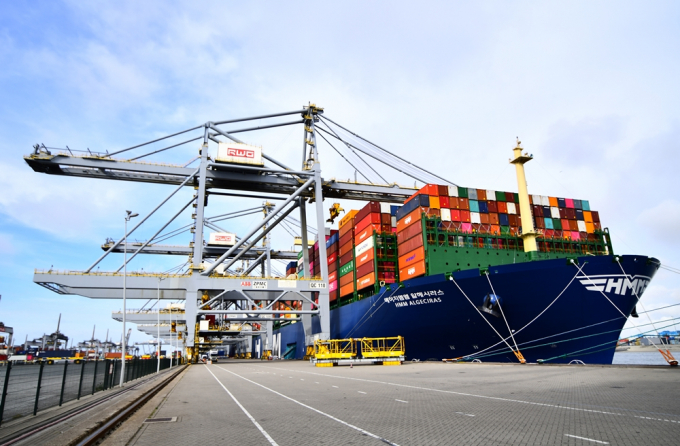HMM to sharply increase container ship fleet by 2030
If it achieves its expansion goal, its cargo capacity will likely triple in 10 years
By Apr 15, 2024 (Gmt+09:00)
LG Chem to sell water filter business to Glenwood PE for $692 million


Kyobo Life poised to buy Japan’s SBI Group-owned savings bank


KT&G eyes overseas M&A after rejecting activist fund's offer


StockX in merger talks with Naver’s online reseller Kream


Mirae Asset to be named Korea Post’s core real estate fund operator



HMM Co., South Korea’s flagship sea carrier, on Monday unveiled a plan to sharply increase the fleet of container and bulk carriers by 2030 to strengthen its global competitiveness, although a plunge in freight rates and a slowdown in major economies paint a grim picture for the shipping industry.
The company, a majority owned by Korea Development Bank (KDB) and Korea Ocean Business Corp. (KOB), plans to increase its cargo capacity to 1.5 million twenty-foot equivalent units (TEU) by 2030 from the current 920,000 TEU.
One TEU equals one 20-feet container. The 150 TEU is equivalent to the combined load capacity of 130 container ships. The 920,000 TEU is the maximum cargo volume of 84 container carriers.
For bulk carriers, HMM plans to nearly double its cargo capacity to 12.28 million deadweight tonnage (DWT), equivalent to 110 vessels by 2030.
That compares to the current 6.3 million DWT, or 36 ships. DWT is a measure of the weight a ship can carry.
HMM will unveil details of its mid-term growth plan within the first half of this year. It currently holds a mere 2.7% share of the global container shipping market, according to the Ministry of Oceans and Fisheries.
The announcement came after its two largest shareholders' attempt to sell a majority stake in HMM to South Korea’s leading poultry processor Harim Co. in a $5 billion deal collapsed in February.

The global shipping industry suffered a plunge in freight rates in 2023 due to the protracted economic slowdown and deliveries of new large-size container ships.
The Shanghai Containerized Freight Index, a benchmark index, plummeted to 1,006 in 2023, compared to 3,410 in 2022 and 3,792 in 2021. On April 3, it was quoted at 1,745.
Further, Asian freight cargo carriers are grappling with the world’s leading shipping companies’ departure from THE Alliance to establish a new alliance among Western carriers in February 2025.
“The low freight rate environment is expected to continue due to the increased supply of large-scale container ships and economic uncertainties in the aftermath of regional conflicts in the world,” the Ministry of Oceans and Fisheries said in a statement released on Monday.
To comply with global environmental standards, HMM is also considering accelerating its zero emissions goal to 2045, five years ahead of its original plan. In line with this target, it will improve energy efficiency, build eco-friendly vessels and secure low-emission fuels.
The ministry said that the Korea Ocean Business will inject fresh capital into domestic shipping firms by acquiring their green bonds.
The state-run agency will also offer new loans to Korean shippers with high environmental, social and governance ratings at lower interest rates than the market average.
Write to Jin-Won Kim at jin1@hankyung.com
Yeonhee Kim edited this article.
-
 Shipping & ShipbuildingHMM, SIPG to cooperate on eco-friendly fuel
Shipping & ShipbuildingHMM, SIPG to cooperate on eco-friendly fuelApr 03, 2024 (Gmt+09:00)
1 Min read -
 Mergers & AcquisitionsHarim gives up HMM deal over management rights dispute
Mergers & AcquisitionsHarim gives up HMM deal over management rights disputeFeb 07, 2024 (Gmt+09:00)
3 Min read -
 Shipping & ShipbuildingHD Hyundai, Hanwha delivers 1st of 12 container ships to HMM
Shipping & ShipbuildingHD Hyundai, Hanwha delivers 1st of 12 container ships to HMMJan 24, 2024 (Gmt+09:00)
1 Min read -
 Shipping & ShipbuildingKorea’s HMM among shippers benefiting from growing Red Sea crisis
Shipping & ShipbuildingKorea’s HMM among shippers benefiting from growing Red Sea crisisJan 05, 2024 (Gmt+09:00)
3 Min read -
 Shipping & ShipbuildingS.Korea’s HMM expands bulk carrier fleet for stable profit
Shipping & ShipbuildingS.Korea’s HMM expands bulk carrier fleet for stable profitNov 02, 2023 (Gmt+09:00)
2 Min read -
 LogisticsHMM to open fastest shipping route from S.Korea to Indonesia
LogisticsHMM to open fastest shipping route from S.Korea to IndonesiaSep 26, 2023 (Gmt+09:00)
1 Min read -
 Shipping & ShipbuildingHMM embarks on biofuel ship pilot testing on global route
Shipping & ShipbuildingHMM embarks on biofuel ship pilot testing on global routeSep 15, 2023 (Gmt+09:00)
1 Min read -
 ESGS.Korea’s HMM tops carbon efficiency ranking on key shipping route
ESGS.Korea’s HMM tops carbon efficiency ranking on key shipping routeMar 02, 2023 (Gmt+09:00)
1 Min read -
 EarningsHMM’s operating profit to fall 80% in 2023 on easing freight rates
EarningsHMM’s operating profit to fall 80% in 2023 on easing freight ratesFeb 13, 2023 (Gmt+09:00)
1 Min read -
 EarningsHMM rakes in record quarterly profits on higher freight rates
EarningsHMM rakes in record quarterly profits on higher freight ratesNov 11, 2021 (Gmt+09:00)
1 Min read


